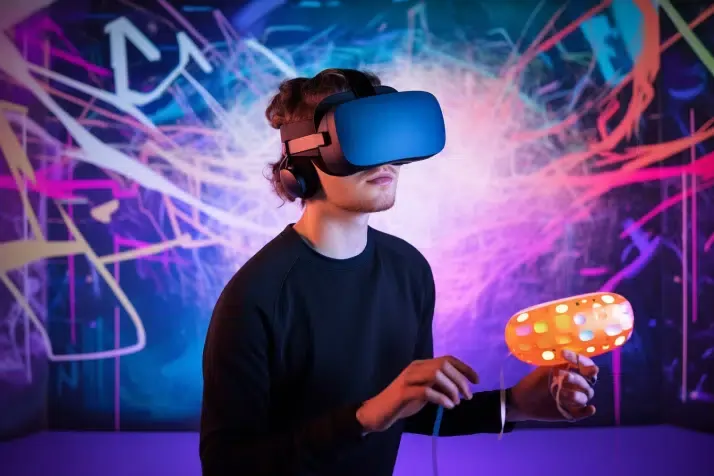History and Evolution of the Metaverse Concept
Explore the intriguing history and evolution of the Metaverse concept, from its key features to immersive virtual worlds. Discover how this ground-breaking idea is changing the way we experience technology.

A Metaverse is a virtual 3D environment accessible over the internet. Users may engage in collaborative activities and/or one-on-one conversations with each other or computer-generated avatars. This is a simulated environment where real-world data is exchanged through the internet. If you want to know more about the history of Metaverse, keep reading.
Social networking, online gaming, learning, and professional development are just a few of the many applications of the Metaverses. Both realistic simulations of the actual world and completely fictional universes are possible with their help.
Their ever-changing and growing nature presents infinite opportunities for discovery and engagement. They offer a unique, fully immersive experience unavailable anywhere else online.
You may be hearing more about the Metaverse than at any point in time, what with Facebook’s recent statement announcing its rebranding as Meta. Let’s dive into the history and evolution of the Metaverse concept. Also, read about the future of the Metaverse economy and what it will look like.

Introduction to the Metaverse concept – Image via Flickr
Key features of the Metaverse
Integration of Avatars
Since they may be either an exact replica of your physical appearance or, a parody of your favorite celebrity, or something wholly original, digital avatars are a novel form of self-expression.
Avatar customization introduces players to the idea of gamification, making for a more interesting and active experience. A more realistic avatar might provide a more compelling experience for the user or audience.
Blockchain technology
Blockchain is an integral part of the Metaverse. It provides users with a way to secure their virtual possessions and evidence of ownership in the form of digital tokens. The quantity, quality, and importance of data in the Metaverse are on the rise.
Data in the Metaverse can only be trusted if blockchain experts and infrastructure are in place to verify it. Additionally, AI is used to safeguard the vast variety of content found there.
Fully submerging events (AR and VR)
By combining elements of the actual and virtual worlds, users of the Metaverse will be able to enjoy more immersive experiences. It’s easy to see why the Metaverse is gaining traction.
It has the potential to make previously inaccessible experiences, including video games, concerts, and plays, as well as professional and educational interactions, seem more real and immersive.
Augmented reality (AR) and virtual reality (VR) are the backbones of every Metaverse project. Connectivity between real and virtual worlds, real-time interaction, and precise 3D object representation are the three pillars upon which augmented reality systems rest.
Interaction with AI
Many AI-based delivery mechanisms exist for bringing the Metaverse’s commercial applications to market. It is expected that artificial intelligence (AI), known as AIOps, which uses machine learning to aid businesses in managing their IT infrastructure, will soon be applicable to the Metaverse platforms as well.
Moreover, businesses increasingly use AI-driven chatbots. Almost human AI bots may be used for a variety of tasks in the Metaverse, including advertising, customer service, and even retail.
Why is the Metaverse important?
The Metaverse is more than a hyped new technology. Years of artificial intelligence and immersive interaction research will revolutionize enterprises.
It’s a novel user-interaction method. You may use the Metaverse to provide clients with more immersive experiences and entertainment. If your firm is the first to provide a Metaverse experience, it will stand out.
Companies may utilize the Metaverse to create immersive, engaging 3D marketing experiences that attract prospective consumers in new, innovative ways.
It’s typical to organize an online and in-person conference. Many individuals cannot go to professional conferences or lectures, but that is no excuse for not learning. A Metaverse conference may be a completely immersive VR experience with networking and participation, unlike a Zoom or Google Meet feed. VR and the Metaverse will immerse viewers.
Numerous companies use augmented reality to let customers digitally test clothes, eyeglasses, furnishings, and makeup. Experiences may be improved in the Metaverse. You may open the Metaverse stores and showrooms if you lease or buy commercial property.
Meta now offers VR workrooms. Workers can read one other’s body language and emotions and maintain an emotional relationship in the Metaverse.
Cryptocurrencies are Metaverse-friendly. Even in early adoption, a crypto wallet is needed to experience the digital world. The Metaverse helps companies regulate transactions in their virtual environment using digital wallets.
Blockchain technology and cryptocurrencies offer more pros than drawbacks for businesses. Cryptocurrency simplifies internet transactions for customers and companies. Virtual worlds don’t need bank accounts; payments merely take a few clicks, and transactions are transparent.
Early origins and history of the Metaverse concept

History of the Metaverse concept
The early origins of the Metaverse concept was found in popular books, movies, and games:
-In the 1950s, science fiction, William Gibson’s Neuromancer and 1982’s Tron introduced the Metaverse. These tales imagined an immersive virtual world people may explore.
-1938: French poet Antonin Artaud introduced the phrase “virtual reality” in his essay collection “The Stage and its Double.”
-1962: “Sensorama” was the first true simulation, a 3D movie with a vibrating chair, fans, and scent that mimicked motorcycling through New York City.
-1992: Novelist Neal Stephenson invented the term “Metaverse” to describe a dystopian future where people interacted and shared virtual worlds.
-The first MMO (Massively Multiplayer Online) game, Ultima Online, was developed by Richard Garriott in 1997 and published a year later. “Second Life” was developed in 2003 to enable individuals to create, socialize, and trade virtual items.
-Three years after its introduction, Roblox became a hit with users who could easily construct virtual worlds out of “blox” bricks or play in other users’ virtual worlds.
-In 2021, Facebook became “Meta,” and Microsoft launched “Mesh,” launching the Metaverse hype. Facebook (Meta) Worlds and Microsoft “Mesh” strive to convince companies to utilize VR and virtual worlds for meetings, seminars, and more.
The emergence of the modern Metaverse
The emergence of the modern Metaverse has been a fascinating process to witness over the past several decades.
The internet revolutionized the way people connect and interact with one another, creating an entirely new virtual world that is slowly becoming more and more intertwined with reality. Online gaming became a popular form of entertainment, allowing players to explore virtual worlds full of exciting possibilities.
Second Life was one of the first major Metaverses to gain mainstream attention. It served as an early pioneer in this cutting-edge technology, providing users with an immersive 3D world where they could customize their avatars, shop for virtual items, and socialize with other players from around the globe.
In many ways, it was ahead of its time, paving the way for future advancements in virtual reality technology.
The Metaverse has since gone mainstream as more companies recognize the potential applications for this unique platform. We are now seeing increasingly sophisticated systems that allow users to access virtual spaces for socializing, entertainment, shopping, education, and even work purposes.
With high-end graphics capabilities and sophisticated algorithms powering these Metaverses, users can enjoy realistic experiences that mimic real-life scenarios in stunning detail and accuracy.
As we move further into the 21st century, it will be exciting to see how the Metaverse continues to shape our ever-evolving digital landscape.
The evolution of the Metaverse
Social media and the Metaverse
Social media and the Metaverse are two phenomena that are rapidly converging in the digital age. The term “Metaverse” defines a virtual shared space created by the convergence of various computer networks.
It is an interconnected network of various virtual worlds and communities that exist within a simulated environment, where people can interact with each other in real-time via avatars.
Through platforms like Second Life and Sansar, users can create their own virtual identities and explore different virtual spaces populated by other users.
Virtual reality and the Metaverse
Virtual reality (VR) technology has opened up new possibilities for users to explore the Metaverse through immersive experiences. Not only can users customize their appearance and movements, but they also have the potential to embark on fully interactive experiences with others in a computer-generated environment.
This opens up an array of opportunities for creative expressions, such as 3D art galleries or virtual concerts, while still allowing users to remain anonymous.
Furthermore, those who have limited mobility or cannot attend physical events due to geographical constraints can now access events virtually through this technology.
The future of the Metaverse
The future of the Metaverse holds great promise for further social interaction in a safe online environment. There is potential for organizations and companies to use this platform as a way to communicate with customers on a personal level without relying solely on traditional methods such as email or phone calls.
Additionally, experts suggest that this could be used to help foster collaboration between teams from different parts of the world, allowing them to better understand each other’s ideas and perspectives by working together in a shared digital environment.
As VR technology becomes more advanced over time, it is possible that we will eventually be able to create our own massively multiplayer online games (MMOs) within these simulations where players from all around the world can come together and experience an entirely new type of gaming experience.
Critiques and challenges of the Metaverse

Delving into the past and learning the history of the Metaverse – Image via World Economic Forum
Privacy and security concerns
The Metaverse collects, stores, and shares a vast amount of user data, making privacy and security concerns extremely important. This data can pose extreme risks if malicious actors acquire or misuse it.
Additionally, there is potential for hackers to gain access to accounts or even control avatars within the Metaverse. Hackers may also be able to exploit and manipulate in-game economies, resulting in large financial losses for players.
The potential for addiction and escapism
The potential for addiction and escapism when using the Metaverse is an important consideration as well.
With its immersive nature and ability to provide an escape from reality, many people may find themselves wanting to stay within their virtual world rather than engaging with reality. This could lead to social isolation, depression, cognitive deficits, and more serious mental health issues if left unchecked.
Economic and ethical issues in the Metaverse
Economic and ethical issues related to the Metaverse are another important consideration. Virtual goods have become a major source of revenue through microtransactions in games such as Fortnite and Animal Crossing: New Horizons. However, these transactions can lead people down a slippery slope of overspending or gambling-like activities. This, in turn, could cause serious financial consequences for players.
There are also moral implications surrounding how we treat others in virtual environments. From hate speech directed toward other players to the exploitation of non-player characters (NPCs).
Conclusion and future outlook
With a fully realized Metaverse, people would be able to connect with each other and digital content in ways that are simply not possible in the physical world. The possibilities for education, entertainment, and business are endless.
However, the challenges ahead are significant. Building a Metaverse is an incredibly complex undertaking, and there are many potential pitfalls. Additionally, it remains to be seen how people will react to living in a virtual world. Will they embrace it or find it too strange and alienating?
Only time will tell what the future holds for the Metaverse. But one thing is certain: it has the potential to change the way we live, work, and play in ways that we can only imagine.




